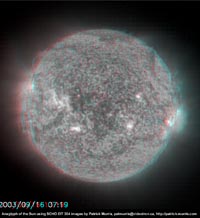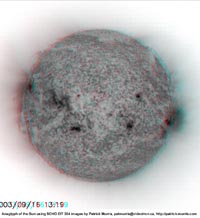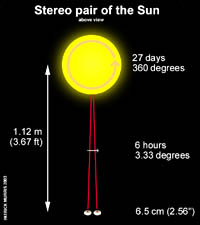 |
SOHO/EIT 304A pictures 980x1067 (221K) |
 |
980x1067 (221K) |
 |
Since it was launched in late 1995, The SOlar and Heliospheric Observatory (SOHO) floats in between the earth and the sun, continuously watching our star with several specialized imaging instruments. The pictures taken one and a half million kilometers from us, are then made available on SOHO's web site a few hours later making it the most distant webcam available on the internet thanks to the European Space Agency (ESA) and the US National Aeronautics and Space Administration (NASA).
The Extreme utraviolet Imaging Telescope (EIT) onboard SOHO is of particular interest as it provides a direct and detailed view of the huge rotating fireball that is ou sun. EIT takes black and white pictures with a succession of four 'colored' filters. Each shot is taken at a different time as the instrument cycles through the four filters in about six hours, providing a daily sequence of four images for each 'color'.
One interesting use of this (almost) uninterupted flow of images is to make animated sequences over a period of several days. In those movies (also provided on SOHO's web site) the slow 27 days rotation of the sun becomes apparent as the gigantic boiling sphere revolves while constantly spitting out bold bridges of plasma, many spanning several earth diameter.
An other interesting approach detailed below is to use two consecutive images as a stereo pair.
A soccerball 3 1/2 feet away
The angular rotation of the sun over six hours is 3.33 degrees, similar to eyes 6.5 centimeters apart looking at a ball 1.12 meter away (3.67 feet). The sun rotates left to right thus the earlier image is the right eye view and the later the left eye view (see figure 1).
To view this stereo pair, one easy way is to combine the two images into an anaglyph to be viewed with red-blue or better red-cyan glasses. To do so, follow the steps below:
- Load the two images in a photo processing software such as Adobe Photoshop. Remember that the earlier image is the right image.
- Convert the right image first to grayscale (Image/Mode/Grayscale) then to RGB (Image/Mode/RGB)
- Convert the left image to grayscale, select all and copy (Ctl-A and Ctl-C)
- Go back to the right image, select the red channel and paste the left image in it (Ctl-V).
- Select the RGB composite channel to view the result.
When viewed with appropriate glasses (red filter on left eye), the sun looks like a half sphere protruding in front of the screen. A more confortable anaglyph can be obtained by shifting the red channel to the left so that features in the middle of the sphere are aligned in all channels. The sun then seems to float beyond the frame of the picture.
However, both images of a proper stereo pair should be taken simultanously. In this case they are six hours apart. Depending on the sun's activity, many features in the two pictures may have changed which may lead to inappropriate results in some parts of the anaglyph. But many features do persist and move in synch with the sphere conveying an overall accurate perception of depth and volume.
SOHO sends back sixteen new images of the sun (almost) everyday, four per filter. Some pair may no fit, but some may also yield some valuable results and truly add another dimension to the already fascinating images.
A sequence of such anaglyphs can also be assembled to produce a stereoscopic movie of the rotating sun.
Similar treatment can be (and have been) applied to consecutive shots taken by orbiters circling other celestial bodies (Earth, Mars, asteroid Eros...).
Stereoscopy is a process by which each eye is provided with a slightly shifted view point on the same scene allowing us to perceive depth and volume. It generally offers a more vivid and detailed depiction of reality by providing the brain with more information then a conventional 'mono' picture.
Links
SOHO's web site
http://soho.nascom.nasa.gov/
The Extreme ultraviolet Imaging Telescope (EIT)
http://umbra.nascom.nasa.gov/eit/
Stereo pairs from Spirit and Opportunity rovers now on Mars, january 2004
http://marsrovers.nasa.gov/home/index.html
History of photography: Stereoscopic photography, by Robert Leggat
http://www.rleggat.com/photohistory/history/stereosc.htm
Mars in 3D from 'Sagan Memorial', 1997
http://mars.jpl.nasa.gov/MPF/sitemap/anaglyph.html
Rainbow Symphony, can provide red and cyan glasses
http://www.rainbowsymphony.com/
Notes
The apparent angular rotation of the sun over six hours should take into account the motion of earth and SOHO during that time which is a little less than a quater degree in the same direction. The angle would then be 3.087 degrees, pushing the ball at 1.21 meter (3.97 feet).
To produce an inverted version of an anaglyph invert (Ctl-I) both images before combining them or invert the final anaglyph and then rotate hue a full 180 degrees (Ctl-U).
Sun rotation is 24 days at the equator and 30 days at the poles - not a solid body.
Sun diameter is about 110 times earth's (1.390.000 km)
Sun distance is about 105 its own diameter (146.600.000 km)
SOHO stands at a little more than a sun diameter from earth, where gravity from our planet and the sun cancel out.
Patrick Murris
http://patrick.murris.com